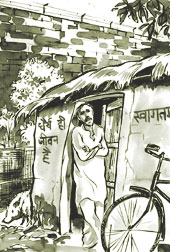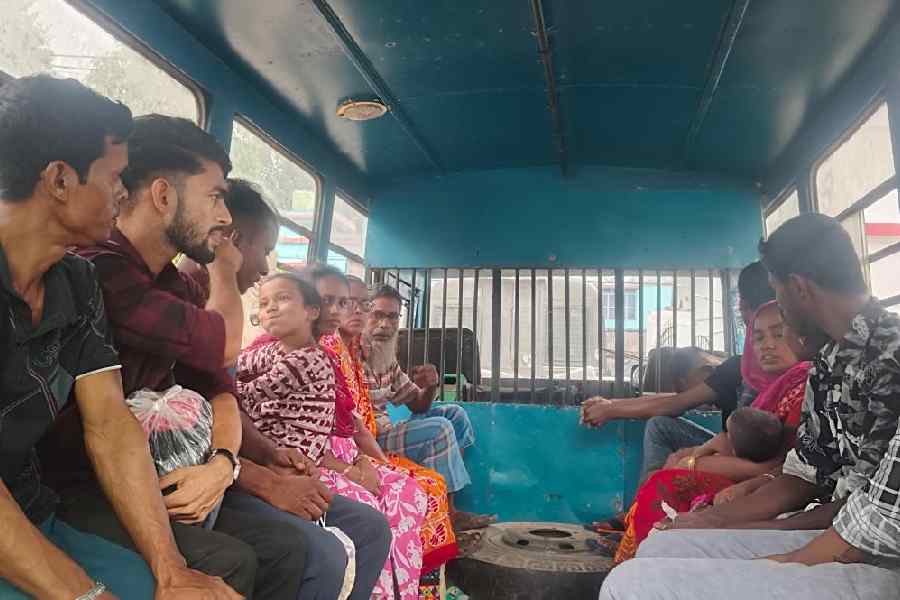 |
Every morning, Navin Sharma dresses up nattily, puts on his Ray-Ban shades and drives away in his Tata Sierra to the site where five trucks owned by him diligently ferry sand to the town’s builders. But by evening, the 33-year-old transporter is in a hurry to get back. For Sharma is also a murderer serving time in prison and has to be present for the evening roll call at Sanganer’s Sri Sampoornanand Bandi Khula Shivir.
Sharma is not the only prisoner in this open jail, located about 16 kilometres from Jaipur, who goes out to work. Most of the 160-odd prisoners, a majority of them convicted killers, earn a living in town. After the 6 am roll call, they leave for their respective jobs as auto-rickshaw drivers, carpenters, tea shop owners and sellers of herbal products. One of them practises Ayurveda. And a couple of them even pay income tax.
Prison reform in Rajasthan is walking a more radical line than even filmmaker V. Shantaram visualised in the 1957 classic, Do Aankhen Barah Haath. At the open jail in Sanganer, a town famous for its inimitable block prints, there are no searchlights, no prison cells, no sentries guarding the prisoners. Here the inmates live with their families in small huts and single-room barracks they usually construct themselves.
The jail is more like a shanty town: dirty kids throw stones at dirtier pigs and women spread washed clothes on the ground to dry. Girls play on see-saws and grey women line up in front of a Shiva temple. And like any other lower-middle class mohalla, the men are out to work.
Sanganer’s bold and innovative experiment which preaches self-reliance has two defining features: economics and emotions. It is good economics because the state has to spend little for the upkeep of the prisoners. The jail staff is a measly four. And, by understanding a convict’s emotions, the open jail has made it mandatory for prisoners to stay with their families. “They act as a form of insurance,” says Laxmi Ashok, whose NGO, Shilpayan, counsels the prisoners’ families.
The jail itself was founded back in 1962, but since 1996 — when the experiment of allowing prisoners to stay with their families and work outside started — there have been only three incidents of violation. One prisoner committed suicide and another overstayed while playing cards during a Diwali night. A third escaped.
Chhetar Mal, 34, sentenced to life imprisonment for killing a rival following a land dispute, explains why everybody comes back. “You escape from jail to be with your family. When I have an opportunity to stay with my family and make a living, why should I try to escape?” he asks.
Not every killer is considered fit enough to be moved to this open jail, where prisoners can go out after the morning roll call but have to be back before sunset. Apart from the fact that he must have spent one-third of his substantive sentence in a regular prison, the convict should also have had a good behaviour record in jail. The jail has no room for those who have committed offences against the state, have been implicated in drugs, involved in bride-burning, rape, multiple offences or are hardened criminals.
Having spent time in claustrophobic, fusty cells where talk mostly hinges on words such as revenge, the prisoners cherish their limited freedom. “I know what my responsibilities are,” says Navin Sharma. “Everyone here is living in a glass house. One mistake can destroy it.”
He should know. The man who admits to his “first and last crime” of killing someone “who had terrorised” his neighbourhood paid an income tax of Rs 17,000 last year. He also has a staff of 15 working for him outside the jail, owns six mobile phones, has a jeep and a Tata Sierra and keeps a labrador and a rottweiler.
Gopal Singh Gujjar, who drives an auto and earns about Rs 150 every day, tells you how the open jail changed him. “I spent six years behind bars. There, I was consumed by a rage all the time. Here I think about my parents, wife and my 14-year-old son. I know what freedom means.”
Like Gujjar and Sharma, the jail has offered others with options, opportunities and a stake in staying on the right side of the law. And that is what keeps the convicts on their best behaviour when working for others within the permitted municipal limits. “These men prove to be better workers since they follow the rules. Also they cannot form unions. We often get requests from businessmen asking for these men,” says Arun Dugar, additional director-general of police, prison, Rajasthan, and the moving spirit behind the experiment.
Even those who do not have to work for a living are happy because the jail allows them to be. Urmila Jain, who was sentenced to 14 years for poisoning her three children — something that she denies — keeps herself busy tending to her kitchen garden overrunning with mogra and rose, mint and basil, lemon and papaya.
Many convicts who belong to different parts of Rajasthan don’t want to go back to their home-towns once released. Many of the ex-convicts have settled in Sanganer pursuing professions they started in jail. One of them is now a lawyer at the Rajasthan High Court.
Sanganer is not the only jail of its kind in Rajasthan. There are similar prisons in Bharatpur, Udaipur and Alwar. “These prisons,” Dugar explains, “are a half-way home, a transit point between incarceration and ultimate social integration.”
Everyone, they say, deserves a second chance. In Sanganer’s open jail, every prisoner is grabbing it with both hands.










